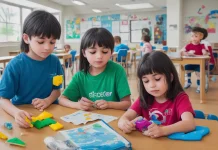Introduction to Mindfulness for Kids with Autism
If you’re a parent or caregiver of a child with autism, you know how challenging it can be to find strategies that help your child calm their mind, improve focus, and manage emotional fluctuations. Mindfulness, a simple but powerful practice, has become an increasingly popular tool for children with autism spectrum disorder (ASD). But what exactly is mindfulness, and why should you consider it for your child?
What is Mindfulness?
Mindfulness is the practice of paying full attention to the present moment, without judgment. It involves becoming more aware of your thoughts, feelings, bodily sensations, and the surrounding environment. While it sounds simple, mindfulness can have profound effects on emotional regulation and cognitive functioning, which is why it’s particularly beneficial for children with autism.
Why is Mindfulness Important for Kids with Autism?
For children with autism, mindfulness exercises can offer a safe space to manage sensory overload, anxiety, and other behavioral challenges. It allows them to focus on their bodies and minds, helping them develop skills to deal with overwhelming emotions. By incorporating mindfulness into their daily routine, children with autism can improve their self-regulation, reduce impulsivity, and even build better social skills.
Benefits of Mindfulness Exercises for Children with Autism
Mindfulness isn’t just about relaxation; it brings many other benefits to children with autism, particularly in terms of their emotional and cognitive growth. Here are some key benefits:
Enhancing Emotional Regulation
Mindfulness exercises help kids recognize their emotions as they arise, giving them tools to manage those feelings before they escalate into a meltdown or outburst. Children learn to acknowledge emotions like frustration, anger, and anxiety without becoming overwhelmed by them.
Improving Focus and Attention
Children with autism often struggle with maintaining attention on tasks or following through on activities. Mindfulness exercises improve focus by training the brain to stay present and engaged, which can enhance performance at school and in everyday tasks.
Reducing Anxiety and Stress
Many children with autism experience heightened anxiety due to sensory sensitivities or social situations. Mindfulness can reduce stress by teaching kids how to calm their mind, relax their bodies, and regain control of their thoughts, reducing feelings of anxiety.
Top 5 Mindfulness Exercises for Kids with Autism
Mindfulness exercises don’t need to be complicated. In fact, simple activities are often the most effective for children with autism. Here are five mindfulness exercises that can easily be incorporated into your child’s routine.
Deep Breathing Techniques
Deep breathing is one of the simplest and most effective mindfulness exercises. By focusing on slow, deep breaths, children can quickly calm themselves when they feel anxious or overwhelmed.
How to Teach Deep Breathing
To teach deep breathing, guide your child to sit comfortably. Instruct them to inhale deeply through their nose for four counts, hold their breath for a moment, and then exhale slowly through their mouth for four counts. You can even make it fun by pretending to “smell the flowers” as they inhale and “blow out the candles” as they exhale.
2. Body Scan Exercise
A body scan is a mindfulness practice where children focus on different parts of their body, noticing any tension or discomfort. This exercise helps kids become more aware of their physical sensations and allows them to release any built-up tension.
Steps to Guide Your Child Through a Body Scan
Start by asking your child to lie down in a comfortable position. Encourage them to close their eyes and take deep breaths. Guide them to focus on one body part at a time, starting with their toes and moving up to their head, gently noticing how each part feels.
3.Sensory Awareness Exercises
Sensory awareness exercises help children tune into their senses, making them more present in the moment. This can be particularly helpful for kids with sensory sensitivities, as it encourages them to notice and control their responses to various stimuli.
Examples of Sensory Awareness Activities
- Touching different textures (e.g., soft fabric, rough surfaces)
- Listening to various sounds (e.g., nature sounds, music)
- Focusing on smells (e.g., flowers, essential oils)
Guided Imagery or Visualization
Guided imagery involves using mental pictures to create a peaceful, calming experience. It helps children take a mental break from the world around them, reducing stress and promoting relaxation.
Creating a Calm and Peaceful Visualization Scenario
Guide your child to imagine a peaceful place, like a beach, forest, or meadow. Ask them to visualize the sights, sounds, and smells of the place, helping them create a detailed mental image that can transport them to a calm space.
5.Mindful Movement
Mindful movement combines physical activity with awareness. It helps children become more attuned to their bodies, making them feel grounded and centered.
Incorporating Movement into Mindfulness Practice
Encourage simple movements such as stretching, yoga, or dancing. As your child moves, ask them to pay attention to how their body feels, noticing the sensations of stretching or bending.
How to Integrate Mindfulness Into Daily Routine
Mindfulness doesn’t have to be a separate activity; it can be integrated into your child’s everyday routine. Here’s how:
Creating a Consistent Mindfulness Practice
Set aside a specific time each day for mindfulness exercises. This could be in the morning, before bed, or during transitions between activities. Consistency helps children build mindfulness skills over time.
Incorporating Mindfulness into Playtime
Mindfulness can also be practiced during play. Play games that encourage focus and attention, like “Simon Says” or memory games, and encourage your child to be fully present in the activity.
Common Challenges and How to Overcome Them
While mindfulness is incredibly beneficial, there are some common challenges when teaching mindfulness to kids with autism. Here are a few tips to help overcome these obstacles:
Keeping Kids Engaged in Mindfulness Exercises
Young children or those with limited attention spans may struggle to stay focused during mindfulness exercises. To keep them engaged, try incorporating fun props or creating short, interactive exercises.
Overcoming Resistance to Mindfulness
Some children may initially resist mindfulness exercises. If this happens, avoid forcing the activity. Instead, make mindfulness a game, reward participation, and introduce new exercises gradually to maintain their interest.
Conclusion: Why Mindfulness Matters for Kids with Autism
Mindfulness exercises are a powerful tool for helping kids with autism improve emotional regulation, reduce stress, and enhance focus. By incorporating these exercises into your child’s daily routine, you can provide them with valuable skills for managing the challenges of autism. The key is consistency, patience, and making the practice enjoyable!
Frequently Asked Questions (FAQs)
1. How often should mindfulness exercises be practiced with children with autism?
It’s recommended to practice mindfulness daily, even if it’s for a short period, such as 5-10 minutes. Regular practice will help children improve their mindfulness skills over time.
2. Can mindfulness help with sensory processing issues?
Yes, mindfulness exercises can help children with sensory processing difficulties by promoting awareness of their sensory experiences and teaching them techniques to stay calm in overwhelming situations.
3. What age is appropriate to start mindfulness exercises?
Mindfulness can be introduced to children as young as 3 or 4 years old. Adapt the exercises to suit your child’s developmental level and attention span.
4. How can mindfulness benefit non-verbal children with autism?
Even non-verbal children can benefit from mindfulness exercises. Focus on sensory-based exercises like deep breathing, body scans, and mindful movement to help them relax and focus.
5. Are there any apps or resources for mindfulness exercises for kids with autism?
Yes, there are several apps designed specifically for kids with autism, such as “Mindful Powers” and “Calm,” which offer guided mindfulness exercises tailored to children.



























